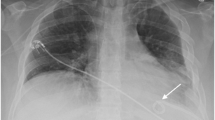Abstract
Objective
To evaluate the efficacy and safety of the treatment of traumatic hemothorax by closed pleural drainage using a central venous catheter (CVC), compared with using a conventional chest tube.
Methods
A prospective controlled study with the Ethics Committee approval was undertaken. A total of 407 patients with traumatic hemothorax were involved and they were randomly assigned to undergo closed pleural drainage with CVCs (n=214) or conventional chest tubes (n=193). The Seldinger technique was used for drainage by CVC, and the conventional technique for drainage by chest tube. If the residual volume of the hemothorax was less than 200 ml after the daily volume of drainage decreased to below 100 ml for two consecutive days, the treatment was considered successful. The correlative data of efficacy and safety between the two groups were analyzed using t or chi-squared tests with SPSS 13.0. A P value of less than 0.05 was taken as indicating statistical significance.
Results
Compared with the chest tube group, the operation time, fraction of analgesic treatment, time of surgical wound healing, and infection rate of surgical wounds were significantly decreased (P<0.05) in the CVC group. There were no significant differences between the two groups in the success rate of treatment and the incidence of serious complications (P>0.05), or in the mean catheter/tube indwelling time and mean medical costs of patients treated successfully (P>0.05).
Conclusions
Management of medium or large traumatic hemothoraxes by closed thoracic drainage using CVC is minimally invasive and as effective as using a conventional large-bore chest tube. Its complications can be prevented and it has the potential to replace the large-bore chest tube.
Similar content being viewed by others
References
Antunes, G., Neville, E., Duffy, J., Ali, N., 2003. BTS guidelines for the management of malignant pleural effusions. Thorax, 58(s2):ii29–ii38.
Clementsen, P., Evald, T., Grode, G., Hansen, M., Krag, Jacobsen, G., Faurschou, P., 1998. Treatment of malignant pleural effusion: pleurodesis using a small percutaneous catheter, a prospective randomized study. Respir. Med., 92(3):593–596. [doi:10.1016/S0954-6111(98)90315-8]
Grodzin, C.J., Balk, R.A., 1997. Indwelling small pleural catheter needle thoracentesis in the management of large pleural effusions. Chest, 111(4):981–988. [doi:10.1378/chest.111.4.981]
Habib, F.A., McKenney, M.G., 2004. Surgeon-performed ultrasound in the ICU setting. Surg. Clin. North Am., 84(4):1151–1179. [doi:10.1016/j.suc.2004.04.003]
Laws, D., Neville, E., Duffy, J., 2003. BTS guidelines for the insertion of a chest drain. Thorax, 58(s2):ii53–ii59.
Parker, L.C., Charnock, G.C., Delany, D.J., 1989. Small bore catheter drainage and sclerotherapy for malignant pleural effusions. Cancer, 64(6):1218–1221. [doi:10.1002/1097-0142(19890915)64:6〈1218::AID-CNCR2820640609〉3.0.CO;2-V]
Parulekar, W., di Primio, G., Matzinger, F., Dennie, C., Bociek, G., 2001. Use of small-bore VS large-bore chest tubes for treatment of malignant pleural effusions. Chest, 120(1): 19–25. [doi:10.1378/chest.120.1.19]
Putnam, J.B.Jr., Walsh, G.L., Swisher, S.G., Roth, J.A., Suell, D.M., Vaporciyan, A.A., Smythe, W.R., Merriman, K.W., DeFord, L.L., 2000. Outpatient management of malignant pleural effusion by a chronic indwelling pleural catheter. Ann. Thorac. Surg., 69(2):369–375. [doi:10.1016/S0003-4975(99)01482-4]
Scalea, T.M., Rodriguez, A., Chiu, W.C., Brenneman, F.D., Fallon, W.F.Jr., Kato, K., McKenney, M.G., Nerlich, M.L., Ochsner, M.G.Jr., Yoshii, H., 1999. Focused assessment with sonography for trauma (FAST): results from an international consensus conference. J. Trauma, 46(3):466–472. [doi:10.1097/00005373-199903000-00022]
Shang, Q., Lou, Q., 2001. Nursing care in the closed thoracic drainage with central venous catheter for pneumothorax. Chin. J. Nursing, 36(4):277 (in Chinese).
Singh, K., Loo, S., Bellomo, R., 2003. Pleural drainage using central venous catheters. Crit. Care, 7(6):R191–R194. [doi:10.1186/cc2393]
Trachiotis, G.D., Vricella, L.A., Aaron, B.L., Hix, W.R., 1997. Reexpansion pulmonary edema. Ann. Thorac. Surg., 63(4):1206–1207. [doi:10.1016/S0003-4975(97)00193-8]
Wu, Z.D., Wu, Z.H., 2003. Surgery, 6th Ed. People’s Medical Publishing House, Beijing, China, p.338 (in Chinese).
Zhang, M., Yang, J., Liu, Z., Gang, J., Xu, S., Jiang, G., 2007. Study on distribution and precise quantification of pleural effusion in mechanically ventilated patients. Chin. J. Crit. Care Med., 27(10):874–877 (in Chinese).
Zhang, M., Yang, J., Xu, S., Ba, L., Liu, Z., Hong, Y., Gang, J., Xu, S., Jiang, G., 2011. Development of a new method to measure pleural effusion volume by ultrasound in critically ill patients. Chin. J. Ultras, 20(2):129–133 (in Chinese).
Author information
Authors and Affiliations
Corresponding author
Rights and permissions
About this article
Cite this article
Yi, Jh., Liu, Hb., Zhang, M. et al. Management of traumatic hemothorax by closed thoracic drainage using a central venous catheter. J. Zhejiang Univ. Sci. B 13, 43–48 (2012). https://doi.org/10.1631/jzus.B1100161
Received:
Accepted:
Published:
Issue Date:
DOI: https://doi.org/10.1631/jzus.B1100161




